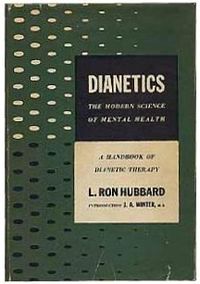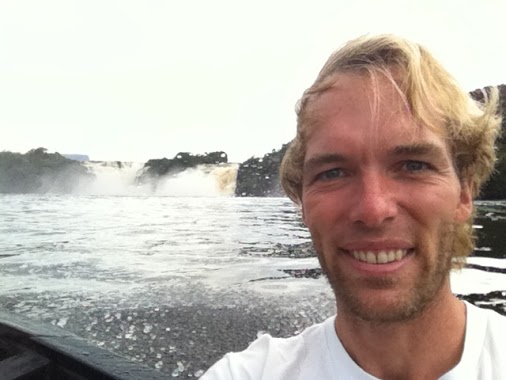 Welcome to our ongoing project, where we blog a 1950 first edition of Scientology’s bible, Dianetics, with the help of ex-Scientologist, lawyer, and author Vance Woodward. Go here for the first post in the series.
Welcome to our ongoing project, where we blog a 1950 first edition of Scientology’s bible, Dianetics, with the help of ex-Scientologist, lawyer, and author Vance Woodward. Go here for the first post in the series.
Vance, we’ve reached the final chapter of this book.
It’s been a long slog — this is our 25th installment, going back to January 4 — and we’re looking forward to your overall thoughts about re-reading this book.
But for now, let’s deal with this final offering from the Commodore.
He starts off this chapter, “Dianetics — Past and Future,” by telling us that his work on Dianetics dates back to 1935, and that 1938 was the pivotal year when he made some of the first key discoveries.
That, of course, rings true with what we know — it was in 1938 when Hubbard had a life-changing experience under the influence of nitrous oxide during a dental procedure and had a sort of weird vision of the universe.
He then gets back to some characteristic boasting, saying that Dianetics is a true science, and that it will soon be moving on to “Plan B”…
Plan B includes further research into life force, an attempt at resolution of some of the ills not yet embraced such as cancer and diabetes, and the perfection of techniques discovered and their dissemination.
And Dianetics is also bound to become useful on a civilization-wide scale, Hubbard tells us.
— There’s “Judiciary Dianetics,” he explains, because once the evil reactive mind is gone and Clears run the world, we’ll have to get rid of our old notions of good and evil.
— With whole nations going clear, there will be less reason for war.
— And with dianetic therapy getting better and more streamlined, it’s tantalizing to imagine where it might lead us.
The way forward that Hubbard imagines is something like a bridge that goes from one plateau, over a canyon, and to a higher plateau.
It has been supposed that no bridge could be built across the canyon and indeed, since those on the lower plateau could not see the higher level, the existence of the higher plateau itself was denied.
Thankfully, there’s a lone engineer with the foresight and imagination to plot and build that inclined bridge to higher land. And once he does, people begin to use it!
And thus, the book concludes with these lines…
In this handbook we have the basic axioms and a therapy which works. For God’s sake, get busy and build a better bridge!
Hubbard would, of course, build on Dianetics, and then, after bankruptcy, start over again in 1952 with “Scientology.” He started establishing “churches” of Scientology at the end of 1953, and eventually developed an incredibly complex and expensive set of training levels which he did, indeed, characterize as a span across a chasm. And ever since, Scientology has been selling a “Bridge to Total Freedom.”
But let’s not get ahead of ourselves.
Vance, please give us your thoughts about this chapter, and then let’s talk about the experience of going through this book for you, many years after you first encountered it.
VANCE: First, Hubbard nailed it with this bit of prescience: “In twenty or a hundred years the therapeutic technique which is offered in this volume will appear to be obsolete.” But come to think of it, doesn’t something have to be useful before it could ever be accused of obsolescence? Anyhow, Hubbard dished out some nuggets that stuck with me the first time I read this chapter. For instance, Hubbard mentions that human groups behave as individual organisms and that societies, just like individuals, have aberrations. I reinterpreted this into economic terms in that otherwise good and sane people can be incentivized to act wrongly and insanely, and to some extent the reverse is true too. Maybe it isn’t mind blowing for those who have already engaged these ideas. But Dianetics was my first exposure to them.
Hubbard also says in this chapter that the cause of human problems isn’t other humans but rather ignorance and inanity. He says, “Attack unreason, not the society or the man.” He left women out of the equation. Maybe he considered women to be congenitally unreasonable and therefore permanently subject to attack. But taking the words as charitably as possible, they seem right-minded.
And he says, “The past acts of an individual who has been cleared should be stricken from his record even as his illnesses have been, for with the cause removed there can be no point in retribution unless society itself is so aberrated that it desires to operate on sadistic principles.” I agree with half of that: if we could actually cure sociopathy, there would be no point in continuing to jail and punish sociopathic criminals. And it all leads the hopeful (and uncritical) reader to the conclusion that Dianetics is the solution to ignorance, insanity and war. A lot of people desperately want that to be true. I did. Either way, it’s a good example of valid generalities being misapplied to specific situations. Just because a cure for insanity would be great doesn’t mean that Dianetics is that cure. Like, no kidding. And yet, I kinda missed this point for many years.
THE BUNKER: Let’s talk about the book as a whole. Going through it again for the first time in quite a few years, what did you find surprised you the most now that you have left the church?
VANCE: What surprises me now is that the book is more like a stream-of-consciousness cult manifesto than a scientific dissertation. I honestly thought the first time I read it that Hubbard had done an excellent job of squeezing much useful information into a small space, and that it was up to me to unzip and extract the content. Any failure was mine alone, which is typical cult-addict mentality. Now I realize the book is just a wince-inducing pile of garbage with nothing in it that is simultaneously novel and correct.
By the way, it amuses me that Hubbard identifies criminals, traitors, and zealots as the society-level equivalent of engrams in this final chapter, given that I found zealots to be disproportionately over-represented among Scientology’s membership. I guess Hubbard got that right too.
THE BUNKER: Before this thorough reading, we were familiar with the concepts of the reactive mind and engrams, and the aims of auditing. But what really surprised us as we really bored in cover to cover is just how much Dianetics is focused on life in the womb, and how misogynistic it is.
A couple of years later, in 1952, Hubbard would start over with Scientology and its emphasis on past lives — re-experiencing life in the womb was quickly de-emphasized. And yet, to this day, Scientology pushes Dianetics on the public as an introduction to the church, even with its obsession on prenatal fantasies. Isn’t that bizarre?
VANCE: Yes, it seems very bizarre from the outside. One day, one accidental utterance during pregnancy could permanently destroy a human mind (but for Dianetic therapy). The next day, prenatal engrams are passé because Hubbard found something even more significant: past lives and theta cooties or whatever.
But it all makes sense if you understand that the believer has already decided that Scientology and Dianetics work. When you’re in, you just accept that Hubbard routinely changed his mind about supposedly important things. Believers assume that contradictory aspects of Scientology and Dianetics are not so much contradictory as just different tools for different situations. And Hubbard gave little guidance on when to emphasize what because he assumed we’d be able to figure it out on our own. But we failed to live up to his expectations. Bummer. At least that’s how I eased my cognitive dissonance.
THE BUNKER: Vance, we’re so glad you could help us out during this adventure. You’ve given us key insights into the minds of Scientologists, and you’ve kept things entertaining when this book did its best to clog up our nerve centers.
Any final thoughts about our trip through the modern science of mental health?
VANCE: Thanks for giving me the opportunity to expostulate. While working on this project, I realized what a self-defeating system Dianetics and Scientology are. With them, Hubbard presents admirable goals of achieving a dynamic personality and long-term happiness, among other goodies. But then we are duped into relying on Hubbard for instructions on how to achieve those things. I was in a mind trap, reliant on someone else to tell me what I needed to do.
I always believed that the keys to success and happiness included large doses of curiosity, openness to new ideas, and the self-confidence to say what is. And yet I somehow brushed all that aside in practice to adhere to Hubbard’s instructions. Like I said: self-defeating. The thing that almost everybody knows that Scientologists (and other cult addicts) don’t know is that we have to figure life out ourselves.
THE BUNKER: Well, Vance, your cogent analysis has been a perfect antidote to reading Hubbard. We really had no idea, when we started this project, just how mind-numbingly bad this book was. But reading it with you has been pure pleasure.
——————–
Scientology Replies to DeCrescenzo in Motion for Protective Order
On Monday, there will be a hearing in Laura DeCrescenzo’s four-year lawsuit against the Church of Scientology for abuse during her 13-year career in its “Sea Organization” — including, she says, a forced abortion when she was only 17.
The church has been fighting a court order that it turn over thousands of pages of evidence in DeCrescenzo’s “pc files” — notes taken during confessionals which the church argues are religious in nature and should be protected under priest-penitent privilege. But Scientology admitted that 259 different church officials compiled and reviewed the notes in those pages, which is one of the reasons Los Angeles Superior Judge Ronald Sohigian decided that the files were not protected under California’s priest-penitent statute.
Scientology has been fighting Sohigian’s order to turn over the documents tooth and nail: It lost an appeal to the California Supreme Court and was just denied an application for an emergency stay to the U.S. Supreme Court.
But the church also filed a motion for a protective order, asking that even if it does have to turn over the documents by Sohigian’s July 2 deadline, it wants the documents kept from public view. DeCrescenzo opposed that, saying that it was too late for the church to be making such a request. Now, in the document below, the church has replied, stressing again the sensitivity of the documents.
We’ll be interested to see how Sohigian rules on Monday. Will he allow the public to see the files? Will he ask that certain items be redacted (names of third parties, etc.)? We’ll find out in a few days.
DeCrescenzo: Scientology Reply
——————–
Posted by Tony Ortega on June 28, 2013 at 07:00
E-mail your tips and story ideas to tonyo94@gmail.com or follow us on Twitter. We post behind-the-scenes updates at our Facebook author page. Here at the Bunker we try to have a post up every morning at 7 AM Eastern (Noon GMT), and on some days we post an afternoon story at around 2 PM. After every new story we send out an alert to our e-mail list and our FB page.
If you’d like to help support The Underground Bunker, please e-mail our webmaster Scott Pilutik at BunkerFund@tonyortega.org







